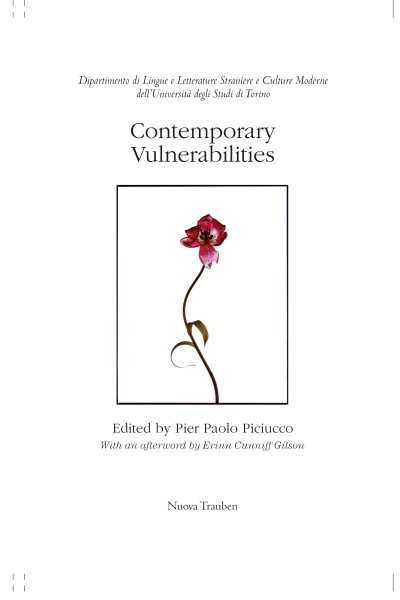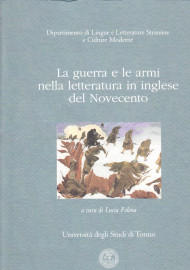Contemporary Vulnerabilities
50,00 €
It is since the early 2000s that notions about how to define vulnerability—and to what extent we can say it affects surrounding topics, or remains affected by them—have been multifariously elaborated and questioned: even more, vulnerability in the twenty-first century has risen to be a dominant concern in academic debate widening its scope and extending its influence in areas as diverse as sociology, economics, ethics, anthropology, ecocriticism, philosophy, literary criticism and psychology; indeed, political studies, as well as legal, gender, trauma, queer and affect, plus a variety of many more subjects, have contributed to amplifying its range.
However, if on the one hand vulnerability analysis may be said to be quite a recent focus of investigation, on the other, it also displays a remarkable array of solutions, progress and amendments mainly resulting from the elaborate, disordinate—at times even unintentional—confrontation of criss-cross perspectives that have driven this research field towards an unpredictably rapid evolution. Quite predictably, though, analyses on social inequalities have provided a formidable springboard to this quick progression; from the very beginning, scholars have brought an imperative focus on the emerging phenomenon of the precariat—the social class positioned at the very bottom of the structures of contemporary societies made of labouring people who, lacking secure jobs or regular incomes, are often forced to migrate. A spotlight on specific subjects, selected on the basis of race, class, gender, ethnicity or immigration status, and generally identified as the immediate victims of neo-liberal policies and contemporary crisis, has marked the evolution of the studies of one of the two main perspectives of this emergent discipline, forcing attention onto social, economic and ideological formation. Parallel to this, however, another orientation, open towards various kinds of cultural, material and bodily vulnerabilities, established a foothold. Studies on vulnerability engaged from this perspective tend to broaden the view of the subject matter, starting from the premise that this is not only a state which affects the have-nots of the world, but rather, is a general and pervasive human experience, and is therefore addressed as an ontological attribute of human existence.
Edited by Pier Paolo Piciucco, Contemporary Vulnerabilities, is a work researching on the notion of vulnerability in contemporary Anglophone literatures. It relies on the critical works by 6 scholars working in the US Universities, Nicholas Birns, Caren Irr, Aimee Pozorski, Heather Hicks, Arne De Boever and Erinn Cunniff Gilson – the book’s guest of honour – 5 in the UK, Dominic Head, Christine Berberich, Ruth Maxey, Diletta De Cristofaro and Michael Greaney, 3 in France, Vanessa Guignery, Jean-Michel Ganteau and Geetha Ganapathy-Doré, 2 in Canada, Josh Toth and Cristina Ionica, plus Rajendra Chetty working in South Africa, Maren Scheurer in Germany and Pier Paolo Piciucco in Italy.
| ISBN | 9788899312909 |
|---|---|
| Autore | Edited by Pier Paolo Piciucco |
| Anno | 2023 |
| Pagine | 350 |
| Casa Editrice | Nuova Trauben |
Descrizione prodotto
Contemporary Vulnerabilities COVER + INTRO
Contents
Introduction
The Myth of the Vincible Achilles, Pier Paolo Piciucco
Section 1 – Fictions of Subjectivity
Beyond the Refusing Self: Vulnerability, Subjectivity, Autofiction, Nicholas Birns
Autoplastic Vulnerability in Contemporary American Memoir, Josh Toth
Section 2 – Ecocriticism
The Wounded Wood: Contemporary Anglophone Fiction and the Forest Caren Irr
Nature Writing and Environmental Insecurity, Dominic Head
Section 3 – Ideology
Capitalism, Precarity and Vulnerability in Arundhati Roy’s My Seditious Heart, Rajendra Chetty
The ‘Vulnerable’ Borders of Britain: Brexit, Eco-Crisis and Building Walls, Christine Berberich
Pretend Vulnerabilities: The Masculinist Drive “Forward” in Martin Amis’s Novels and Current Political Discourse, Cristina Ionica
Section 4 – Gender
Philip Roth’s Vulnerable Women: Trauma and the Ethics of Listening, Aimee Pozorski and Maren Scheurer
Section 5 – Anthropocentrism vs. Zoocentrism
“Strays […] who […] Never really Become Part of Life”: Human and Nonhuman Vulnerability in Sigrid Nunez’s The Friend, Ruth Maxey
Section 6 – Apocalyptic Fiction
“Stripped of These Things They Were Kin”: Tracking Judith Butler’s Post-9/11 Conception of Vulnerability
in Recent Apocalyptic Fiction, Heather Hicks
Contemporary Literature of the End Times, Diletta De Cristofaro
Section 7 – Aestheticism
Art and Injury in Siri Hustvedt’s What I Loved: Philosophical Perspectives, Arne De Boever
Section 8 – Dependance, Care and Affect
Responses to Vulnerability in Kazuo Ishiguro’s Klara and the Sun (2021), Vanessa Guignery
No Continent Is an Island: Jon McGregor’s Lean Fall Stand, Jean-Michel Ganteau
Relational Dynamics in a Care-dependant Family: Kanya d’Almeida’s Short Story “I cleaned the—”, Geetha Ganapathy-Doré
“Some Wound or Something”: Kazuo Ishiguro and the Forms of Vulnerability, Michael Greaney
Focus on the Inexplicable: an Analysis of John Burnside’s A Summer of Drowning and Graham Swift’s Here We Are, Pier Paolo Piciucco
Afterword
Vulnerability’s Significance, Erinn Cunniff Gilson
Informazioni aggiuntive
| ISBN | 9788899312909 |
|---|---|
| Autore | Edited by Pier Paolo Piciucco |
| Anno | 2023 |
| Pagine | 350 |
| Casa Editrice | Nuova Trauben |




